Updated 29th May 2019, with the botanical names for Omilo/ Umilo
I am an explorer. The thrill of discovery is blood to my bones such that rifling – if you can call electronically paging through pdfs that – through documents about the organoplectic nature of xyz are adventure hunts for me. One of the things that I’m really concerned about, giving voice to is the names. The names of Nigerian ingredients – little known, under utilized and not celebrated enough spices, fruits, vegetables.
I’m of the opinion that we need to know more, research more, document more about that which we have in the hope that we will find new uses and applications that have broad meaning for the masses, across health and wellness spheres, addressing food security needs. Enter my chart – my beloved introduction to Nigerian peppersoup. It isn’t the first time I’ve written about the essential ‘Niger-Delta’ peppersoup ingredients. In fact, that post – my first on peppersoup remains the most read post on the blog.
If you want to make your own blend, you’ll find the recipe here
It took me ages to put this card together because I was searching for the botanical name of one spice -umilo/ omilo/ emilo. In the end, after a hundred thousand (well, almost, and it certainly feels like it) searches, I came up with nought and decided to go ahead and publish it anyway. Publish it in the hope that someone, somewhere might happen upon this and say, ‘Ya, I know this’. Also, I am going to do a blog post on it next because I have different types of it, so that who knows, someone might discover that they indeed know what it’s called. Anyway, I hope you enjoy this. It is an updated version of old posts, with more details on each spice and herb
1. Calabash Nutmeg
Other names: African nutmeg
Botanical name: Monodora Myristica
Local Names: Erhe – Urhobo; Iwo – Itsekiri; Ehuru – Igbo; Ariwo – Yoruba; Gujiya dan miya – Hausa; Ukposa – Bini
Consists of: Shell and seed
Parts Used: Seed
Uses: condiment in soups, combined to make spice blends for peppersoup
2. Gbafilo
Other names: Rough-skinned/ Grey/ Guinea plum
Botanical name: Chrysobalanus icaco
Local Names: Gbafilo/ Gbafilor– Itsekiri And out of interest, in Brazil, it is known as Grageru or Abageru
Consists of: Sandpaper like shell and kernel
Parts Used: kernel
Uses: condiment in soups, combined to make spice blends for peppersoup
3. Grains of Selim
The fruits are narrow, slightly torulose, dark brown or black, about 2in. long, borne many (separate carpels) together on a stout peduncle (The Useful Plants of West Africa)
Other names: African/ Guinea/ Ethiopian Pepper
Botanical name: Xylopia Aethiopica
Local Names: Urheri – Urhobo; Unien – Bini; Atta – Ibibio/Efik; Uda – Igbo; Eeru – Yoruba
Consists of: Skin and seeds. The seeds are bitter
Parts Used: both – the skin is used more often, ground and added to soups or bruised and used whole
Uses: condiment in soups, combined to make spice blends for peppersoup, added to agbo (bitters), put in water to purify it, added to palm wine as a flavourer.
4. Uziza
Other names: Bush Pepper, Guinea cubebs, West African Black Peppers
Botanical name: Piper Guineense
Local Names: Edusa – Ibibio; Eti-nkeni – Efik; Uziza – Igbo; Iyere – Yoruba
Consists of: Dried black berries
Uses: condiment used in soups, rice, etc
5. Alligator Pepper
Other names: Grains of Paradise
Botanical name: Aframomum Melegueta
Local Names: Ehie ado – Bini; Ntuen – Efik; Ose oji/ okwa – Igbo; Oburo – Yoruba
Consists of: Skin and seeds. The seeds are aromatic and pungent, with some strains of cardamom flavour
Parts Used: the seeds are ground and added to soups, stews; also chewed with kolanuts where it produces a numbing effect
Uses: condiment in soups, combined to make spice blends for peppersoup, added to agbo (bitters), put in water to purify it, added to palm wine as a flavourer.
6. Tetrapleura Tetraptera
Other names: Prekese [Ghana]
Botanical name: Aframomum Melegueta
Local Names: Aridan – Yoruba; Edem Inang – Efik; Ighimiakhie – Bini; Usho usho – Igbo
Consists of: long winged fruit pods, two hardy, two soft and sweet edible wings.
Parts Used: soft wings are edible and used
Uses: ground for soups, roasted and ground for soups and sauces. Ground pulp is sometimes added to palm wine to flavour it.
7. Umilo, Omilo
Other names: Cocoplum [Caribbean]
Botanical name: Chrysobalanus icaco
Local Names: Omilo/ Umilo – Itsekiri
Consists of: Shell and seed/ kernel
Parts Used: Shell is broken and seed/ kernel inside is used.
Thank you x

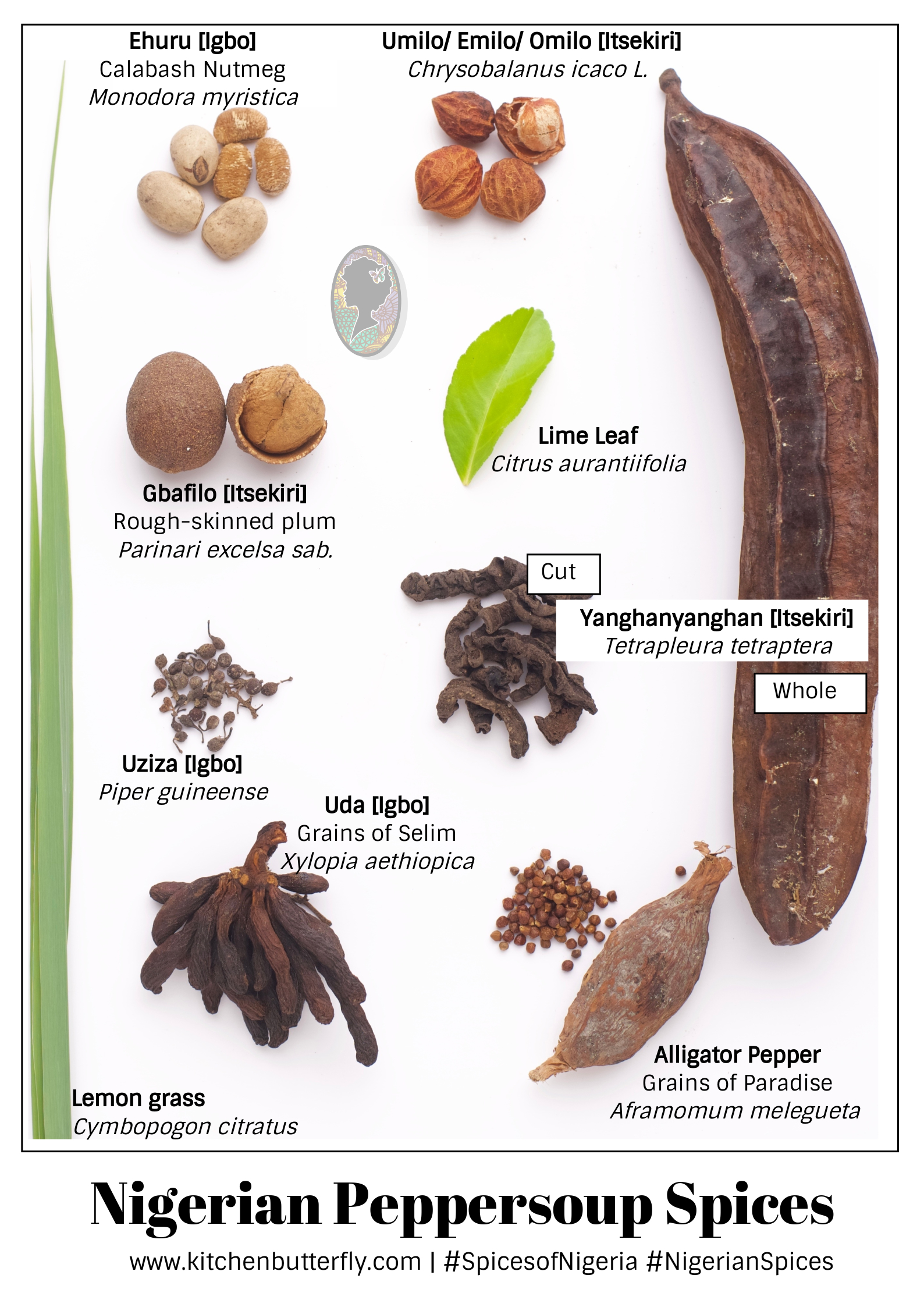
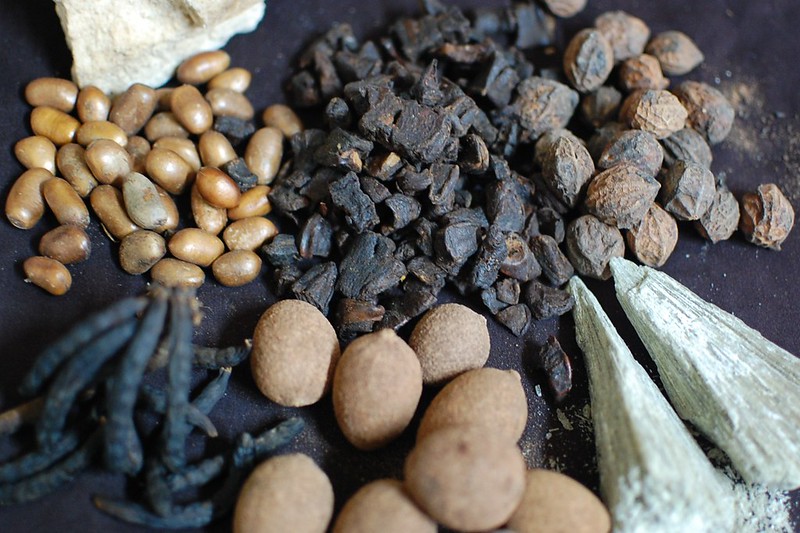
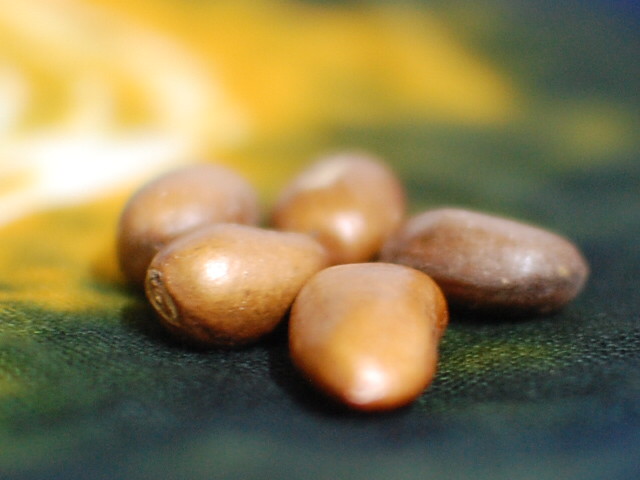
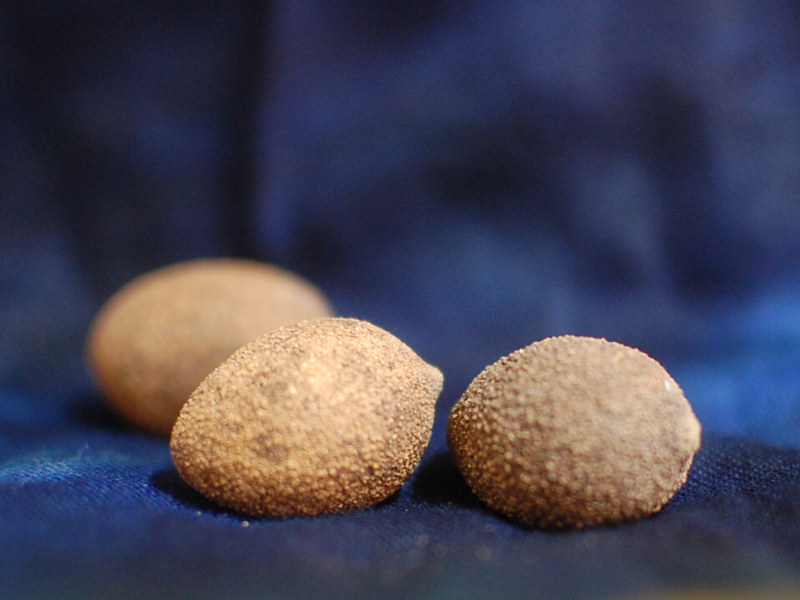

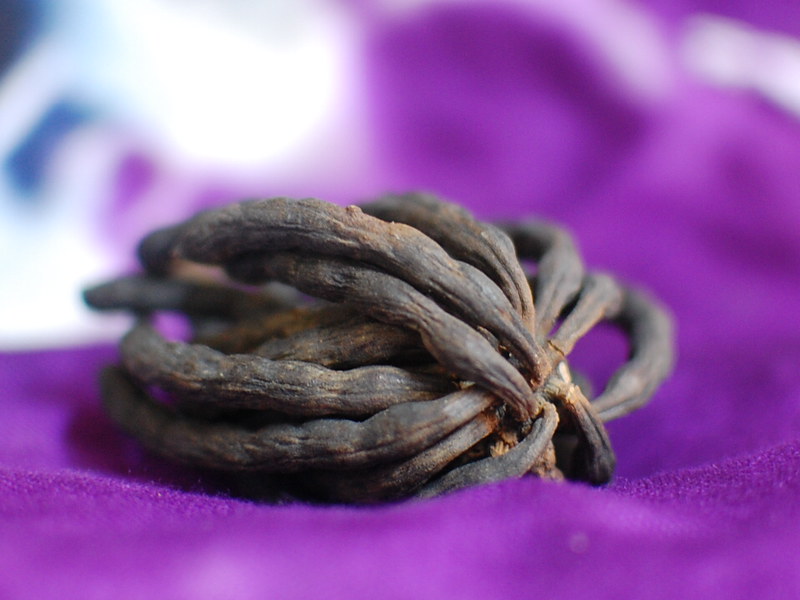


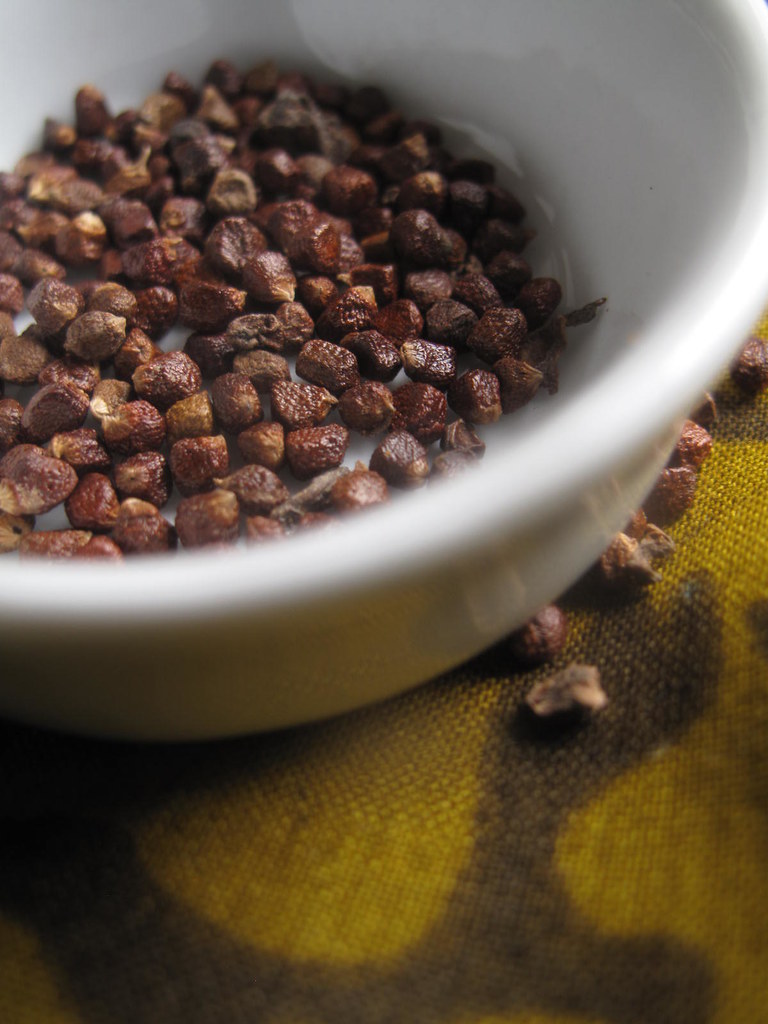
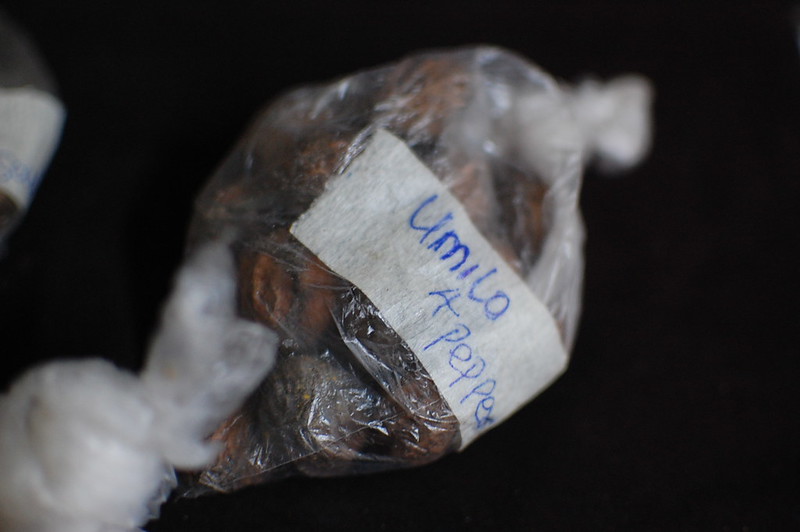
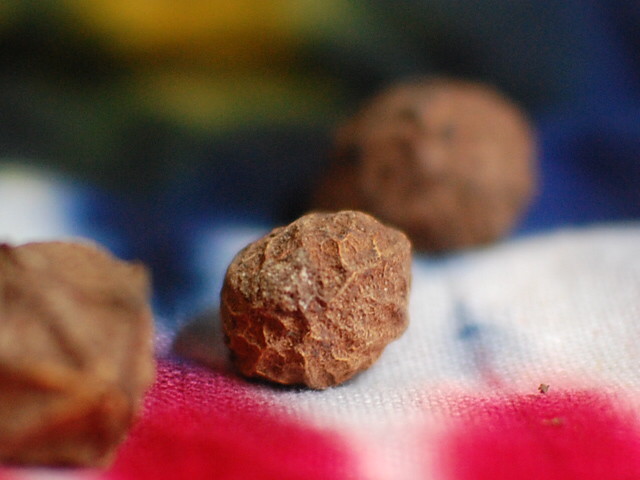
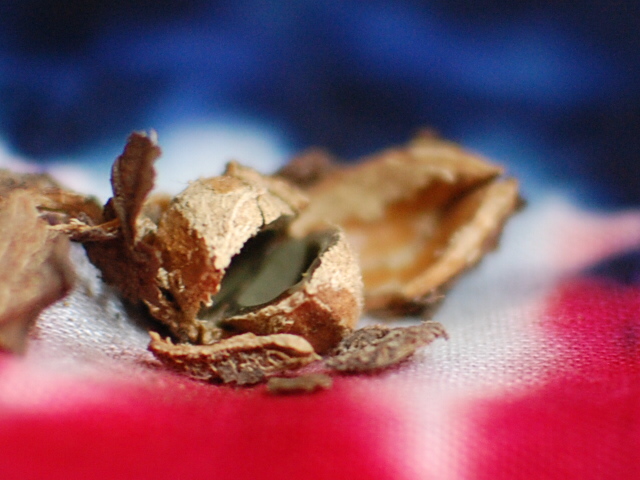


Thank you very much for this, I really love it but pls ma, how can I know the measurements to use for each of them if I want to blend all together for home use?
Hi, here’s a link https://www.kitchenbutterfly.com/2014/ukodo-nigerian-yam-pepper-soup-pottage-for-new-years-day/
Cheers
That Erhe in particular? i have been searching for the right name for it, but it wasn’t easy till i came across this website! Thank you very much for saving me hours of work!
I was researching khaya grandifoliola seeds when I came across this. The umilo seed looks like it. From my research though it has only four segments unlike umilo that has six-eight.
Worthy article!
Thank you for a job well done.
I was curious about Nigeria spices especially their health benefits as I just started a new youtube channel where I intend to touch ethnic specific dishes. This piece has been useful in knowing their names. I will now build on this for details of health benefits and recipes. My channel is Foodis Pathwaytolife.
Splendid well done ma
Kindly describe local spices for cough and the preparation
🙂 – I’m sorry, that’s not my area of specialty
Well done! Please is orioma seeds also called ataiko or irugeje?
Hi, please is Calabash nutmeg available in Nigeria. If yes what part of the country can we find it? Thanks.
Yes it is – most markets across the country will have it. From Lagos markets to those in the east, south etc
Hello good day I saw you message
I can supply you calabash nutmeg directly from delta state Nigeria
Good write up will come back to tell you the other name of omilo
Thank you! I look forward to adding it to the other names
This is an excellent resource. Thank you for making it. Would you mind if I transferred your translations to Wiktionary, so they can be more widely-used, including by people who don’t speak English?
If you come across similar puzzles in the future, uploading botanical picture to Wikimedia Commons (the image repository for Wikipedia) is a good way to get them identified. If you add your uploaded photo to “Category:Unidentified food” or “Category:Unidentified spices”, or both, someone will often come and identify it. If not, ask at the Village Pump or Help Desk, and they will help you find someone to ask for an identification. There are professional botanists and botanical organizations active on Commons; you have a good chance of getting an authoritative answer.
I’ll try to remember to check back here for any reply. Thanks again!
Thank you for this – very useful. What translations are you looking to transfer?
You won me over with this piece, you couldn’t have done it better. Amazing is the word. Painstakingly done. Well done ma. Blessings
Thank you very much
Great job,thanks for this…
You’re welcome
Thank you for this information.I’ve been buying pepper soup mix but the taste is different from the one I use in Nigeria. Been searching for a while now to know the exact ingredients in order to make my own.
Awesome
[…] previousOn Pepper Soup Spice & Finding Names random next 1 view 0 likes 0 comments […]
Nigerian cuisine is beautiful and complex. It spices and fruits deliver simplicity and elegance.